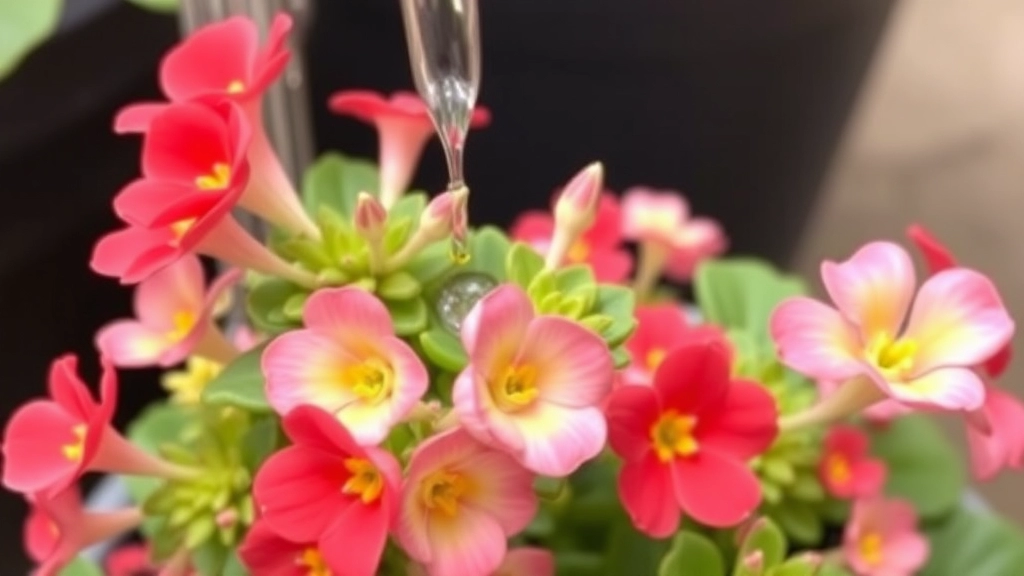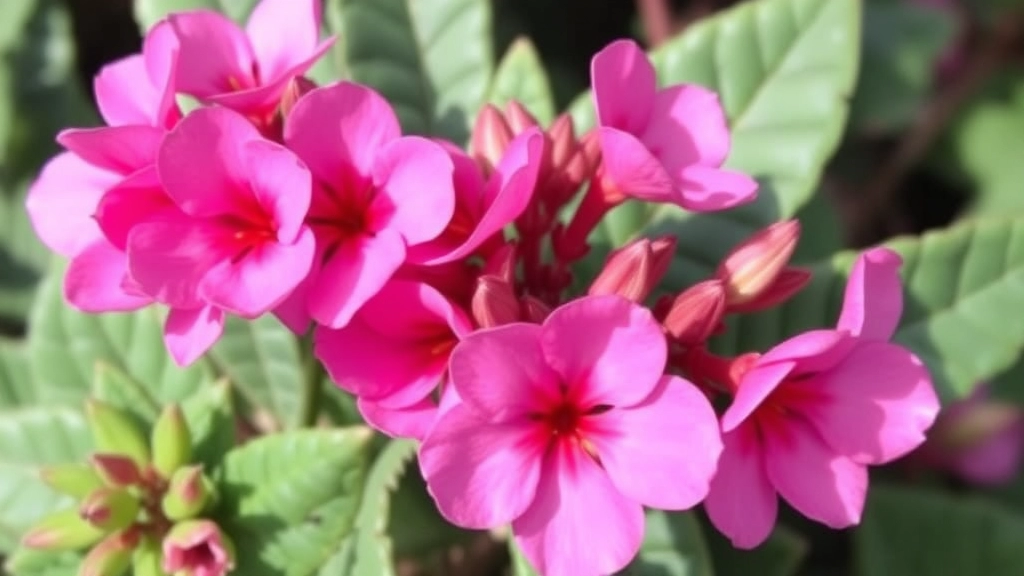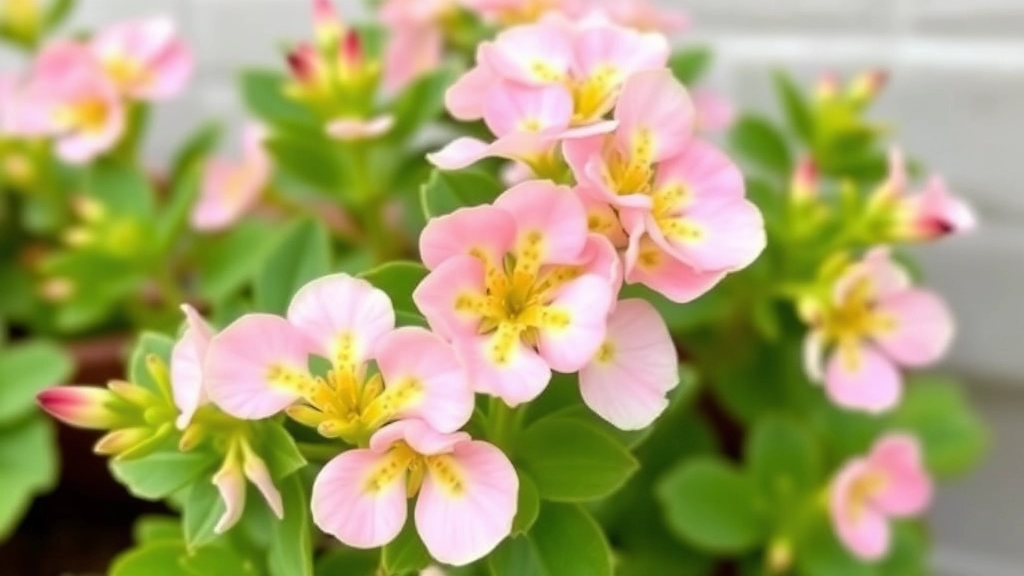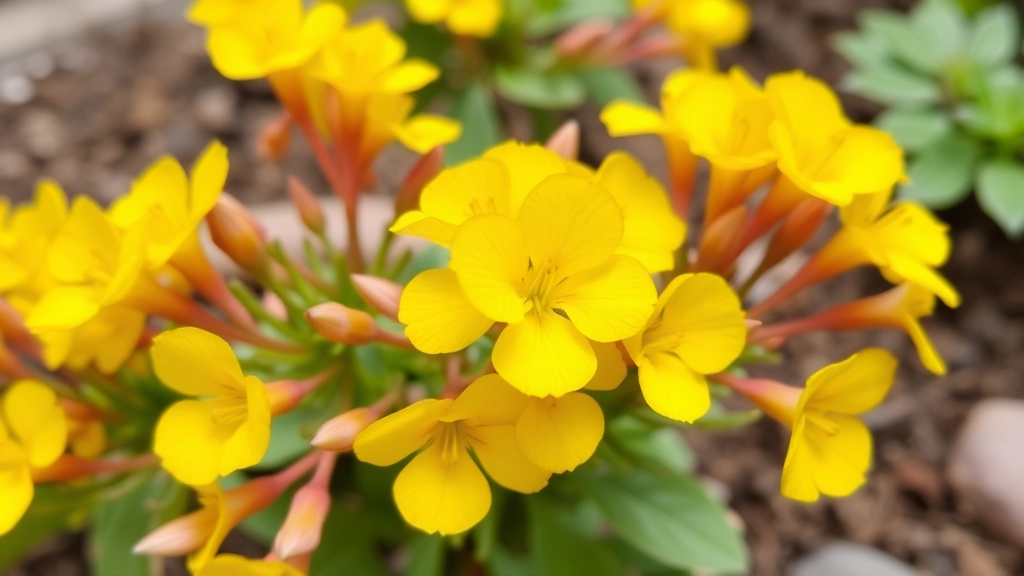Kalanchoe Blossfeldiana Yellow
Looking to add a splash of colour to your home with the Kalanchoe Blossfeldiana Yellow? This vibrant plant is not only eye-catching but also relatively easy to care for. With its bright yellow blooms, it’s perfect for both indoor and outdoor décor. Let’s dive into how to grow and maintain this stunning plant.
Care Instructions
First off, Kalanchoe Blossfeldiana Yellow thrives in well-draining soil and requires moderate watering. Make sure to place it in a spot with plenty of sunlight to keep those blooms vibrant.
Propagation
If you’re interested in propagation, this plant is quite forgiving—just follow some simple steps, and you’ll have new plants in no time.
Pest Management
Keep an eye out for common pests and diseases, and you’ll enjoy your Kalanchoe Blossfeldiana Yellow for years to come.
Best Growing Conditions for Yellow Kalanchoe
When it comes to nurturing your Yellow Kalanchoe, understanding its ideal growing conditions is essential. You may wonder, “What does my plant need to thrive?”
Light Requirements
Yellow Kalanchoe, or Kalanchoe Blossfeldiana, flourishes in bright, indirect sunlight.
- Optimal Light: Aim for 6 hours of light daily.
- Avoid Direct Sunlight: Too much direct sun can scorch the leaves.
Temperature and Humidity
Temperature plays a crucial role in the health of your Kalanchoe.
- Ideal Temperature: Keep it between 18°C to 24°C (65°F to 75°F).
- Humidity Levels: This plant prefers moderate humidity.
Potting and Placement
Choosing the right pot and location can make all the difference.
- Potting: Use a pot with drainage holes to prevent waterlogging.
- Placement: A south-facing window is often the best spot.
Seasonal Considerations
Different seasons can affect growth.
- Spring and Summer: Growth is vigorous; ensure adequate watering.
- Fall and Winter: Reduce watering as the plant enters dormancy.
Watering Tips for Kalanchoe Blossfeldiana

So, you’ve got your stunning Yellow Kalanchoe Blossfeldiana, and you want to make sure it thrives. One of the biggest worries for plant lovers is getting the watering just right. Too much water, and you risk root rot; too little, and your plant might droop.
Here are some straightforward tips to help you nail the watering routine:
- Check the Soil: Stick your finger about an inch into the soil. If it feels dry, it’s time to water. If it’s still moist, hold off for a bit.
- Water Deeply: When you do water, give it a good soak. Ensure that water drains out of the bottom of the pot. This encourages the roots to grow deeper.
- Frequency: During the growing season (spring and summer), you might need to water every 1-2 weeks. In winter, cut back to once every 2-3 weeks.
- Use Room Temperature Water: Cold water can shock the plant. Let your water sit out for a bit before using it.
- Avoid Water on Leaves: Try not to get water on the leaves, as this can lead to fungal issues. Water the base instead.
Remember, Kalanchoe Blossfeldiana is a succulent, so it prefers to be on the drier side.
How to Propagate Kalanchoe Blossfeldiana Yellow
If you’ve ever wondered how to expand your collection of Kalanchoe Blossfeldiana Yellow, you’re not alone. Many plant enthusiasts seek to propagate this vibrant succulent, and it’s easier than you might think.
Methods of Propagation
- Leaf Cuttings
- Select a healthy leaf from the parent plant.
- Allow the cut end to dry for a day or two, forming a callus.
- Place the leaf on well-draining soil and lightly mist it.
- Keep the soil moist but not soggy.
- Stem Cuttings
- Cut a healthy stem just below a node.
- Remove the lower leaves to expose the stem.
- Let the cutting dry for a day to form a callus.
- Plant it in soil and water lightly.
- Offsets
- Look for small offsets or pups around the base of the plant.
- Gently separate them from the parent plant.
- Replant them in their own pots with suitable soil.
Tips for Successful Propagation
- Temperature: Aim for a warm environment, ideally between 20-25°C.
- Light: Provide bright, indirect light to encourage growth.
- Humidity: Moderate humidity is beneficial; avoid overly dry conditions.
By following these straightforward methods, you can easily propagate your Kalanchoe Blossfeldiana Yellow and enjoy the beauty of multiple plants in your home.
Common Problems and Solutions for Kalanchoe Blossfeldiana

As we delve deeper into caring for your Yellow Kalanchoe, it’s essential to address some common challenges you might encounter. Knowing how to identify and resolve these issues can make all the difference in keeping your plant thriving.
1. Overwatering
Symptoms:
- Yellowing leaves
- Wilting despite wet soil
- Root rot
Solutions:
- Ensure proper drainage by using pots with holes.
- Allow the top inch of soil to dry out between waterings.
- If root rot occurs, remove affected roots and repot in fresh soil.
2. Underwatering
Symptoms:
- Drooping leaves
- Dry, crispy edges
Solutions:
- Water thoroughly when the soil feels dry.
- Increase humidity if the air is too dry, especially indoors.
3. Pests
Common pests include aphids and mealybugs.
Symptoms:
- Sticky residue on leaves
- Visible insects or webbing
Solutions:
- Wipe leaves with a damp cloth.
- Use insecticidal soap or neem oil for severe infestations.
4. Lack of Blooms
Symptoms:
- Healthy foliage but no flowers
Solutions:
- Ensure the plant receives adequate light (6 hours of bright, indirect sunlight).
- Adjust fertilisation schedule; use a balanced fertiliser during the growing season.
5. Leaf Drop
Symptoms:
- Leaves falling prematurely
Solutions:
- Check for temperature fluctuations; Kalanchoe prefers stable conditions.
- Avoid moving the plant frequently.
How to Encourage Blooming in Yellow Kalanchoe
Have you ever wondered why your Yellow Kalanchoe isn’t blooming as vibrantly as you’d hoped? Encouraging your Kalanchoe Blossfeldiana to produce those stunning yellow flowers can be a rewarding experience. Here are some effective strategies to ensure your plant thrives and blooms beautifully.
1. Light Requirements
- Bright Indirect Light: Place your Kalanchoe in a spot where it receives plenty of bright, indirect sunlight. Too little light can hinder blooming.
- Avoid Direct Sun: While they enjoy light, direct sunlight can scorch the leaves.
2. Temperature Control
- Warm Environment: Kalanchoe prefers a temperature range of 18-24°C (65-75°F).
- Avoid Cold Drafts: Keep your plant away from cold drafts or sudden temperature changes.
3. Watering Practices
- Moderate Watering: Allow the soil to dry out between waterings. Overwatering can lead to root rot, which affects blooming.
- Water Less in Winter: During the dormant season, reduce watering frequency.
4. Fertilisation
- Balanced Fertiliser: Use a balanced, water-soluble fertiliser every month during the growing season (spring and summer).
- Dilution is Key: Dilute the fertiliser to half strength to avoid nutrient burn.
5. Pruning for Blooming
- Deadheading Flowers: Regularly remove spent blooms to encourage new growth and more flowers.
- Light Pruning: Trim back any leggy growth to promote bushier plants.
6. Stress for Blooms
- Controlled Stress: Sometimes, a little stress can encourage blooming. Reduce watering slightly before the blooming season to stimulate flower production.
Outdoor and Indoor Uses for Kalanchoe Blossfeldiana

So, you’ve got your vibrant Yellow Kalanchoe Blossfeldiana and you’re wondering where to show it off?
Indoor Uses:
- Table Centerpiece: Plop it in the middle of your dining table. It adds a pop of colour and liveliness to your meals.
- Windowsill Delight: Perfect for bright windows. It thrives in sunlight and brightens up your space.
- Office Companion: A great desk plant. It’s low-maintenance and can boost your mood while you work.
- Gift Idea: Wrap it up nicely for a friend. It’s a charming gift that lasts.
Outdoor Uses:
- Garden Borders: Use it to line pathways or flower beds. The yellow blooms create a cheerful vibe.
- Patio Planters: Combine it with other succulents. It’s a great addition to your outdoor decor.
- Hanging Baskets: Perfect for those vertical gardens. The cascading blooms look stunning.
- Pollinator Friendly: Attract bees and butterflies. It helps support local wildlife.
Whether you’re sprucing up your home or garden, Kalanchoe Blossfeldiana is versatile and can fit in anywhere.
Pruning and Maintenance of Yellow Kalanchoe
When it comes to keeping your Yellow Kalanchoe thriving, understanding the importance of pruning and maintenance is essential. You might wonder, how often should I prune? What are the signs that my plant needs some attention?
Pruning Tips for Yellow Kalanchoe:
- Timing: The best time to prune your Kalanchoe is after the blooming period, typically in late spring. This allows the plant to focus its energy on new growth.
- Tools: Use clean, sharp scissors or pruning shears. This prevents any potential disease from affecting your plant.
- What to Cut:
- Remove dead or wilted flowers to encourage new blooms.
- Trim back any leggy growth to promote a bushier appearance.
- Snip off any leaves that appear damaged or diseased.
- Technique: Make clean cuts just above a leaf node. This encourages new growth from that point.
Maintenance Tips:
- Light: Ensure your Yellow Kalanchoe receives bright, indirect sunlight. A lack of light can lead to leggy growth, making pruning even more necessary.
- Fertilizing: Use a balanced, water-soluble fertilizer every four to six weeks during the growing season. This supports healthy growth and vibrant blooms.
- Pest Control: Regularly check for pests like aphids or mealybugs. If found, treat them promptly with insecticidal soap.
- Repotting: Consider repotting every couple of years to refresh the soil and provide more room for growth.
Ideal Soil and Fertilizer for Kalanchoe Blossfeldiana
Now that we’ve covered how to keep your Kalanchoe Blossfeldiana thriving, let’s dig into the soil and fertilizer it craves.
What’s the Best Soil?
You might be wondering, “What type of soil does my yellow Kalanchoe need?”
Well, here’s the scoop:
- Well-Draining Soil: Kalanchoe loves to breathe. A mix designed for succulents is perfect.
- pH Level: Aim for a slightly acidic to neutral pH (around 6.0 to 7.0).
- DIY Mix: You can whip up your own by combining:
- 1 part potting soil
- 1 part perlite or coarse sand
- 1 part orchid bark
This combo keeps moisture in check while allowing excess water to escape.
Fertilizer Tips
Now, let’s talk about feeding your plant.
- Type of Fertilizer: A balanced, water-soluble fertilizer works wonders.
- Dilution: Always dilute it to half the recommended strength. Kalanchoe prefers a light touch.
- Frequency: Feed it every 4-6 weeks during the growing season (spring and summer). Skip the fertilizer in autumn and winter to avoid overfeeding.
Signs Your Plant Needs More Nutrients
Keep an eye out for these signs:
- Pale Leaves: This could mean it’s hungry.
- Stunted Growth: If your Kalanchoe isn’t growing, it might need a nutrient boost.
By ensuring your yellow Kalanchoe has the right soil and fertilizer, you’re setting it up for success.
Safety and Toxicity Considerations for Pets and Children
When considering the beauty of Yellow Kalanchoe (Kalanchoe Blossfeldiana) in your home, it’s crucial to think about its safety, especially if you have pets or young children.
Is Kalanchoe Safe for Pets and Children?
Yellow Kalanchoe is indeed a stunning addition to any indoor or outdoor space, but it does come with some safety concerns.
- Toxicity Level: Kalanchoe is classified as mildly toxic to pets, particularly cats and dogs.
- Symptoms of Ingestion: If ingested, pets may experience symptoms such as:
- Vomiting
- Diarrhoea
- Lethargy
- Drooling
For children, while it’s generally safe, ingestion can lead to similar gastrointestinal issues.
Precautionary Measures
To ensure the safety of your loved ones, consider these simple steps:
- Placement: Keep Kalanchoe out of reach of children and pets.
- Education: Teach children about the plant and the importance of not touching or eating it.
- Monitoring: Regularly check on your plants to ensure no curious hands or paws have gotten too close.
What to Do in Case of Ingestion
If you suspect that a pet or child has ingested Kalanchoe:
- Contact a Vet or Poison Control: Immediate consultation can provide guidance on the next steps.
- Observe Symptoms: Keep an eye on any unusual behaviour or physical symptoms.
FAQs about Kalanchoe Blossfeldiana Yellow
How often should I water my Yellow Kalanchoe Blossfeldiana?
Water your Kalanchoe deeply every 1-2 weeks during the growing season (spring and summer). In winter, reduce the frequency to once every 2-3 weeks.
What are the signs of overwatering my Kalanchoe Blossfeldiana?
Overwatering symptoms include yellowing leaves, wilting despite wet soil, and root rot. Ensure proper drainage and let the top inch of soil dry out between waterings.
How can I tell if my Kalanchoe Blossfeldiana is underwatered?
Underwatered Kalanchoe will have drooping leaves and dry, crispy edges. Water thoroughly when the soil feels dry and consider increasing humidity if the air is too dry.
What pests should I watch out for on my Kalanchoe Blossfeldiana?
Common pests include aphids and mealybugs. Look for sticky residue on leaves and visible insects or webbing. Wipe leaves with a damp cloth and use insecticidal soap or neem oil for severe infestations.
Why isn’t my Yellow Kalanchoe Blossfeldiana blooming?
If your plant has healthy foliage but no flowers, ensure it receives adequate light (6 hours of bright, indirect sunlight) and adjust your fertilization schedule with a balanced fertilizer during the growing season.
What should I do if my Kalanchoe Blossfeldiana is dropping leaves?
Leaf drop can be caused by temperature fluctuations or frequent movement. Keep the plant in stable conditions and avoid moving it frequently.
Can I grow my Kalanchoe Blossfeldiana indoors?
Yes, Kalanchoe Blossfeldiana can thrive indoors. It makes a great table centerpiece, windowsill plant, office companion, and even a charming gift.
How can I use Kalanchoe Blossfeldiana in my outdoor garden?
Outdoors, it can be used for garden borders, patio planters, hanging baskets, and to attract pollinators like bees and butterflies.
What type of soil is best for Kalanchoe Blossfeldiana?
Kalanchoe prefers well-draining soil, ideally a mix designed for succulents. Aim for a slightly acidic to neutral pH (around 6.0 to 7.0). You can create a DIY mix with equal parts potting soil, perlite or coarse sand, and orchid bark.
How often should I fertilize my Kalanchoe Blossfeldiana?
Use a balanced, water-soluble fertilizer diluted to half strength. Feed your plant every 4-6 weeks during the growing season (spring and summer) and avoid fertilizing in autumn and winter.
What are signs that my Kalanchoe Blossfeldiana needs more nutrients?
Look for pale leaves and stunted growth as indicators that your plant might need more nutrients.
References
-
How to Grow Kalanchoe – Gardener’s World
-
Kalanchoe Succulent Plant Profile – The Spruce
-
Kalanchoe: How to Grow and Care for Kalanchoe – The Old Farmer’s Almanac
